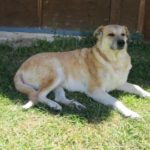The Essence of the Senior Dog
A long time client has asked me some questions regarding her senior dogs. And I thought I would share my answers in a blog.
Now, what defines a senior or geriatric dog? Generally, a dog is considered a senior around the age of seven with the typical lifespan being 12 to 15 years of age. Of course, this number is going to vary among breeds and individual dogs.
I’ve read articles that claim dogs are living longer thanks to conventional veterinary science. But, as a result of a longer life, dementia or Canine Cognitive Dysfunction is becoming more and more common in senior dogs. I don’t believe dementia is a normal condition of old age. I have relatives who are well into their 90s and they all have their mental faculties intact. And I have had animals that have lived well beyond 18 years and I have never seen cognitive decline. Recent research has shown there are common human medications that have been linked to dementia (link), including Benadryl, which is also given to animals. Sugar has also been linked to dementia (link). So, perhaps this is the case with dogs. All those vaccines, drugs, chemicals, and processed commercial pet food just might be the cause behind many of the chronic diseases and cognitive dysfunctions we are seeing in older pets. Unfortunately, there hasn’t been any research to connect the dots in animals.
A veterinarian friend of mine said that she and her colleagues remember back in the 1960s-70s dogs were living into their twenties. So what has changed?
Personally, I don’t think we really know how old an animal can reach. There are stories of dogs and cats living into their late 20s and 30s. One famous dog was an Australian cattle dog named Bluey that lived more than 29 years. Then there is the cat named Crème Puff that lived to 38 years and Lucy that lived to 39 years. If you do a search on Google you will find many other cats and dogs that lived well pass the so-called average age of 15 years. What’s the secret? It could be genetic, or it could be environment.
Recently, a preliminary study took a look at the whole-genome sequence of two extremely old dogs – age: 22 and 27 years (or 90-135% more, than the average lifespan of dogs) – in order to make the first steps to understand the genetic background of extreme longevity in dogs. The researchers identified more than ∼80 1000 novel SNPs in the two dogs (7500 of which overlapped between them) when compared to three publicly available canine SNP databases, which included SNP information from 850 dogs. Read study here.
Q1: Age 9 ( the age of our dogs) has been on several lists as being the average life span of the Pyrenees and German Shepherd breeds. Our dogs are half of each. Would the cross-breeding tend to lengthen or shorten their lifespan, or is that impossible to say and futile to contemplate?
The consensus is mixed breed dogs live longer than purebreds. Big dogs have a shorter lifespan than small breeds whether they’re mixed or not. A mixed-breed dog often has the advantage of having a much lower chance of being born with inherited congenital diseases, since the mating process naturally leaves out the defective genes. On the other hand, a mixed breed is still not a guarantee of superior health. There are instances where a mixed breed dog is born with the negative genetic traits of the breeds it is descended from.
A study published in the Journal of American Veterinary Medical Association (2013) based on the medical records from the veterinary clinic at UC Davis for 27,254 dogs and compared the incidence of 24 genetic disorders in mixed versus purebred dogs, suggested that mixed breed dogs don’t necessarily have an advantage when it comes to inherited disorders. Listed below are some of their findings:
1) The incidence of 10 genetic disorders (42%) was significantly greater in purebred dogs.
2) The incidence of 1 disorder (ruptured cranial cruciate ligament; 4%) was greater in mixed breed dogs.
3) For the rest of the disorders examined, they found no difference in incidence between mixed and purebred dogs.
In conclusion: The researchers found that the prevalence of 13 of the 24 genetic disorders was approximately the same in purebred dogs as in their mixed-breed counterparts. Ten were found more frequently among purebred dogs, and one such disorder was more common in mixed-breeds.
You can read the study here and the abstract here
Q2: What are some of the signs of natural ageing in dogs besides the outer ones we can easily see–an increase in strains, pains and sleep time? What signals are sent out by the organs, the digestion, appetite, the energy levels, the emotional life?
In Traditional Chinese Medicine, they speak of something called Essence, or the Jing. It is the stuff that makes living beings distinct from inorganic things. It forms and unfolds throughout the life cycle, from conception to death.
Essence has two sources. One, is the Prenatal Essence which is inherited from the parents. Even though it is the fusion of both parents, it is unique to the individual’s Original Chi and will determine a particular growth period. Second, is the Postnatal Essence and it is derived from the purified parts of ingested food and continuous physical, emotional, and mental stimulation from the environment. The Postnatal Essence allows for modification of Prenatal Essence. Together, they compose the over-all Essence of the person (or, animal).
The Traditional Chinese Medicine book, called the Nei Jing, speaks of the changes in the Essence over time. It is divided between the genders: the female’s seven-year stages of transitions, and the male’s eight-year transitions (Since cats and dogs have a shorter life span than humans, adjustments would need to be made for their life stages). I’m not going to get into each individual stage, but it shows how the Essence (which is seated in the kidneys) rises and then falls throughout the life cycle.
In my blog on “Kidney Disease” I write how the Essence is located in the Kidneys and that it fuels the whole body: “As we grow older the Essence decreases in its physical vitality. So, this would mean the kidney ying and yang is weakening. The ailments that we often see in our senior animals, like loss of hearing, dull and graying coat, hind legs weakness, poor appetite, teeth loss, would be described in Chinese Medicine as a Kidney Deficiency.”
Q3: Do dogs need a change in diet just because they’re “seniors”?
An older dog needs to eat high-quality protein and essential fatty acids. If you have been feeding your dog a species appropriate diet of raw meat and organs, please continue with this diet. It’s important to keep your dog’s weight stable. Do not let your dog become over weight…at any age. Obesity can put a strain on the musculoskeletal system and added wear and tear can result in arthritis. This can lead to trauma and injuries.
Fat is not an innate tissue. It just doesn’t sit on the hips and do nothing but give us a big butt. It is a highly active tissue that secretes several hormones that creates low-grade inflammations throughout the body and this inflammation can lead to cancer, arthritis, heart disease, and more. Obesity is associated with oxidative stress, which makes a major impact on aging and the central nervous system. The brains of overweight senior dogs accumulate oxidative damage to proteins and lipids, which may lead to dysfunction of neuronal cells. The production of free radicals and lack of increase in compensatory antioxidant enzymes may lead to detrimental modifications to important macro-molecules within neurons. To avoid this, keep your dog slender and feed a fresh, species appropriate diet, and you may add anti-oxidative supplements.
Q4: Do dogs know and hide the changes they must be feeling as the years pile on?
This may be hard to believe, but at one time veterinary scientists didn’t think animals experienced pain. It took until 1987 for the American Veterinary Medical Association to recognize and assess pain in animals or even to provide alleviation for such pain. Before that, they only acknowledged that animals showed the physiological correlations of pain, such as nerve impulses, changes in hormonal levels, and reduced movement. But because they were afraid of being accused of anthropomorphism, scientists refused to believe animals responded emotionally to pain the way humans do.
One of the reason for such belief is the way animals hide their pain. They are so good at hiding their pain that a pet owner would have to have good observation skills to notice the subtle changes in behavior: A cat would go off somewhere and hide, often times in very unusual places (my mother once found her sick cat curled up inside the microwave oven), a dog with a painful toothache may remain still and quiet, an injured fox being chased by dogs would continue to run without yelping, a horse in pain may hint their discomfort by only a subtle posture change, or a wrinkling of the nose.
In the wild, it would make sense an animal would hide their injuries so not to alert their predators. Any sign of weakness could mean death. As Cindy Engel writes in her book Wild Health, “To survive, an animal must not only be healthy, but must look healthy.”
This is also true in keeping status within a group’s hierarchy. A high ranking lion, stag, or wolf would want to hide any sign of weakness to avoid being replaced by a younger, healthier animal. Demotion would mean not getting first choice at meal time or having access to females to pass on their DNA. So, if an injury or a sickness can be concealed while they heal, perhaps a loss of status can be avoided.
I don’t think animals understand death or disabilities the way humans understand it. I once had a tortoiseshell cat named Katie. At the age of 18, she had a stroke and became paralyzed on the right side of her body. She couldn’t walk anymore, so I made her a bed by the radiator to keep her warm and comfortable. I had to feed her by hand, and when she needed to go to the bathroom she would meow to let me know and I would hold her over the cat box. When my family and friends would visit me they would try to shame me by saying “Katie is suffering. Put her to sleep.”
But I don’t believe Katie was suffering. She just couldn’t walk anymore. I don’t think Katie laid in her bed, thinking “My life sucks” or, lament that she’ll never be able to chase birds again. The mistake humans make is projecting their feelings onto animals (Surely, they must feel what we feel). When we euthanize a sick animal we are doing it for ourselves. It is the human who can’t bear suffering. Animals don’t feel sorry for themselves. They live in the moment. They accept everything. Life is what it is.
Q5: Our dogs have not been spayed, nor bred. Now the time between their heat cycles seems to be longer, with less bleeding. Do heat cycles continue throughout a female dog’s lifetime?
Normally, an intact female dog will go through estrus twice a year. The age at which their cycles start and the duration of the cycle vary greatly between the breeds of dogs and individual dogs, but, in general, dogs come into heat about twice a year.
As a dog approaches their senior years they begin to lose fertility and ovarian function. However, dogs do not go through menopause and should continue to go into heat their entire life. If the time between cycles become longer with less bleeding this may indicate a hormonal imbalance or an ovarian disease.
Abnormal heat cycles may be a number of things: If a dog is not showing outward signs of estrus she may be having what’s called a “silent heat.” A dog in normal heat will show several outward signs that alert other dogs, and humans, that she is in heat. With a silent heat, these external and internal symptoms such as vaginal bleeding, discharges and swollen vulva are barely visible, if at all. But, the dog will still be fertile, so pregnancy is a possibility.
Prolonged intervals between heat cycles that are approximately 16-months apart may indicate an ovarian cyst that is producing progesterone and this may either stop estrus or prevent it from occurring. However, there are other health conditions that can prolong intervals between estrus, such as, hypothyroidism or Cushing’s Disease.
For more information, please see this link.
Q6: Is it true that not being spayed and not breeding makes them more vulnerable to cancer?
There’s been quite a bit of research regarding the health effects of intact vs desexed dogs in large and giant breeds. Spaying and neutering may reduce diseases in the reproductive organs, but studies have shown desexing increases the risks for other diseases, such as, obesity, musculoskeletal disorders, incontinence, and several types of canine cancer.
It takes approximately 18 to 24 months for all the bone plates to close in a dog. The bone plates in the hips are the last to close. The sex hormones play an important role in bone growth, bone density, muscle maintenance, and proper bone development and remodeling. Since, it’s a conventional veterinary practice to neuter/spay dogs around 4 to 5 months of age, this bone growth and development is interrupted. Thus, early desexing increases the chances of hip dysplasia, and cranial cruciate ligament (CCL) ruptures, a degenerative joint disease.
Removing the sex organs will decrease benign prostatic hyperplasia, mammary tumors, perianal tumors, and prevent testicular tumors, prostatic carcinoma, uterine, ovarian and vaginal tumors. However, desexing does increase incidences of mast cell tumors in females, and in both sexes, an increase in lymphoma, osteosarcoma, hemangiosarcoma, and transitional cell carcinoma of the bladder.
For further reading on the link between spaying, neutering, and cancer: Read the Vizsla breed study.
Q7: When the dogs were young, they could be let out the gate to roam, and sometimes they disappeared for 3- 5 hours, sometimes until after dark. Now, after a 1½-hour chaperoned walk in the morning, they sleep for 5 hours. What is appropriate daily exercise time for a large senior dog? Currently Gunga is getting about 2 ½ hours, 1½ in the morning and one or 1½ in the evening. Ellie has started to decline the evening walks.
Since senior dog Ellie pulled a muscle in a dead run chasing a faun, and recovery has been difficult, is she likely to hurt herself again in the next chase? I doubt she will remember and restrain herself when instinct and adrenaline kick in. Probably dogs take longer to heal as they get older?
Yes, just like in humans, dogs, too, experience the aches and pains of aging. It’s important to watch their weight, keep them lean through exercise and diet. Some deterioration in the joints and tissues may occur as they age, but this shouldn’t stop you from playing with your dog or going on walks together. Physical activity is important for a senior dog. It’s a mental stimuli and keeps them happy.
For dogs, it’s vital to have an exercise routine to keep the body fit and flexible. This will help prevent trauma or injuries. If they’re slowing down you can still connect with them through massage or acupressure. Massage can help relax the dog and release tension in muscles. Acupressure is good for relieving pain. Some good acupressure points are GB 34 for any muscle pain and pain in the flanks; GB 30 for pain in the hind limb; BL 25 for pain in the hip and lumbar spine. For more information on acupressure for dogs, check out Animal Acupressure Illustrated Dog.
Supplements can help slow down degeneration and inflammation in the joints. Glucosamine aids cartilage repair and is safe. It can help reduce pain and improves joint function. Glycosaminoglycans is an important natural therapy, and can be found in New Zealand green-lipped sea mussel. Omega-3 fatty acids such as fish oils can help reduce inflammation.
Q8: How will we know that she’s fully healed?
In Helkinst Homeopathy there is a belief that every trauma, whether emotional or physical, always stay with us, and in some way, will always still affect us. These past traumas can actually prevent full healing unless they are also addressed. That’s why I do sequential remedies where we move from the present event and all the way back to birth, removing every trauma one-by-one. Often when I do sequential remedies, a past trauma may surface for a day or two. The idea is to deal with it for a final time, get it out of the “system,” and then let it pass.
Q9: When they were 4, both got really sick with tick fever. You made a tonic for them—based on their symptoms and histories—Phos for Ellie, and Sulph for Gunga—30c. They recovered. Maybe older dogs need their own personal daily tonic?
The homeopathic remedies Sulphur and Phosphorus that I gave to Ellie and Gunga were based on their genotype, or personality. The genotype has to do with an animal’s constitution which is state of good health, a typology. It is received at conception and remains for life unless the animal suffers shocks or traumas. In which case, it will be pushed into an imbalance state and the primary constitution is now invisible. During an illness, an animal can emotionally go out of balance. So, the idea is to bring the dog back to his old self before the illness.
On the other side of the coin there is the phenotype constitution. It is a coping mechanism that forces an animal to shift in response to some form of stress. Think of a friendly, happy dog that is abandoned in an animal shelter and suddenly becomes a scared, nervous dog that snaps at people or other dogs.
Once treatment has removed the disease state and the source of stress is no longer present, it’s possible for the animal to shift back into its genotypical constitution.
I often give a herbal tonic for senior animals to address some of the common ailments brought on by aging (or, by allopathic medicine): such as, cognitive decline, restlessness, anxiety, or insomnia, etc. Or, I will use homeopathy to address not just the physical, but emotional issues, also.
Q10: They love us, we know, but could they be pining to return to Sirius (the Dog Star)—leaving us barbarians down here to our fate?
One of my favorite books I read as a child was Jack London’s “Call of the Wild.” For those who don’t know the story, I’ll give a quick synopsis: it’s a story about a St. Bernard-Scott Shepherd mixed dog named Buck. He lived in the Yukon, Canada, and because of his large size he was stolen by some men who wanted to use him as a sled dog. Unfortunately, he was abused and passed around by humans until Buck finally ended up in the possession of a man named John Thornton. He was a kind owner, and the dog and the human developed a strong bond. One day, Thornton was attacked and killed by an Indian tribe called the Yeehats. Buck hunted down the murderers and killed them in revenge. Then Buck escaped into the wilderness where he is attacked by a pack of wolves. But he wins the fight and becomes the leader of the pack. Every year, on the anniversary of the Yeehats attack, Buck comes out of the wilderness to visit the campsite where he last saw his human companion and mourns Thornton’s death.
I think this book summarizes the relationship between humans and dogs. There’s always a little bit of wolf, a little bit of primordial instinct in our dogs. But I don’t think they will ever leave us.
All dog lovers should read “Call Of The Wild.”











